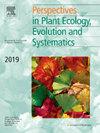How do plants survive in the starving, burning, and hiding vegetation realms generated by novel fire regimes?
IF 2.9
3区 环境科学与生态学
Q1 ECOLOGY
Perspectives in Plant Ecology Evolution and Systematics
Pub Date : 2025-06-05
DOI:10.1016/j.ppees.2025.125885
引用次数: 0
Abstract
Fire has been an important evolutionary force across many vegetation types worldwide, but human activities and climate change currently impose novel and unprecedented fire regimes. In some areas, fire is and will be excluded, while in others, fire activity will be increased either in intensity or frequency. Changes resulting in fire exclusion should create novel environments where competition for light dominates (starving realm), filtering out species with the costliest adaptations against fire. In areas where fire intensity will increase, fire should filter out species with aboveground parts exposed to the strongest impacts of the flames (hiding realm). Areas exposed to higher fire frequencies should promote species capable of quickly building protection between fire events (burning realm). Based on well-investigated savanna-forest mosaics in the Cerrado, we propose a set of plant adaptations and strategies that should be favoured or unfavored under different novel fire regimes. In the starving realm, species with the capacity to better explore vertical space and maintain competition for light with surrounding plants will likely be favored. In the hiding realm, species with strategies based on escaping flame exposure (for example belowground) will likely be favored. In the burning realm, species capable of shielding themselves from flames and quickly investing in aboveground protection in between fires should be favored. Finally, more than just promoting a collection of traits, novel fire regimes are expected to filter contrasting plants’ growth forms that perform better in fast vertical exploration, quick canopy expansion, or belowground strategies, imposing cascading consequences over vegetation structure and defining novel habitats for a wide range of organisms.
植物是如何在饥饿、燃烧和隐藏的植被领域中生存的?
火灾是世界范围内许多植被类型的重要进化力量,但人类活动和气候变化目前强加了新的和前所未有的火灾制度。在一些地区,火灾已经并将被排除在外,而在另一些地区,火灾活动的强度或频率将会增加。导致火灾排除的变化应该创造出一种新的环境,在这种环境中,对光的竞争占主导地位(饥饿领域),过滤掉那些适应火灾成本最高的物种。在火灾强度会增加的地区,火灾应该过滤掉地上部分暴露在火焰最强烈影响下的物种(隐藏领域)。暴露于较高火灾频率的地区应该促进能够在火灾事件之间快速建立保护的物种(燃烧领域)。基于对塞拉多热带稀树草原-森林马赛克的充分调查,我们提出了一套植物适应和策略,在不同的新火灾制度下应该是有利的或不利的。在饥饿的环境中,有能力更好地探索垂直空间并与周围植物竞争光线的物种可能会受到青睐。在隐藏领域,有躲避火焰暴露(例如地下)策略的物种可能会受到青睐。在燃烧的领域,能够保护自己不受火焰伤害并在火灾之间迅速投资于地面保护的物种应该受到青睐。最后,除了促进性状的集合,新的火灾制度有望过滤对比植物的生长形式,在快速垂直探索,快速树冠扩张或地下策略中表现更好,对植被结构施加级联后果,并为广泛的生物定义新的栖息地。
本文章由计算机程序翻译,如有差异,请以英文原文为准。
求助全文
约1分钟内获得全文
求助全文
来源期刊
CiteScore
6.50
自引率
0.00%
发文量
28
审稿时长
67 days
期刊介绍:
Perspectives in Plant Ecology, Evolution and Systematics (PPEES) publishes outstanding and thought-provoking articles of general interest to an international readership in the fields of plant ecology, evolution and systematics. Of particular interest are longer, in-depth articles that provide a broad understanding of key topics in the field. There are six issues per year.
The following types of article will be considered:
Full length reviews
Essay reviews
Longer research articles
Meta-analyses
Foundational methodological or empirical papers from large consortia or long-term ecological research sites (LTER).

 求助内容:
求助内容: 应助结果提醒方式:
应助结果提醒方式:


